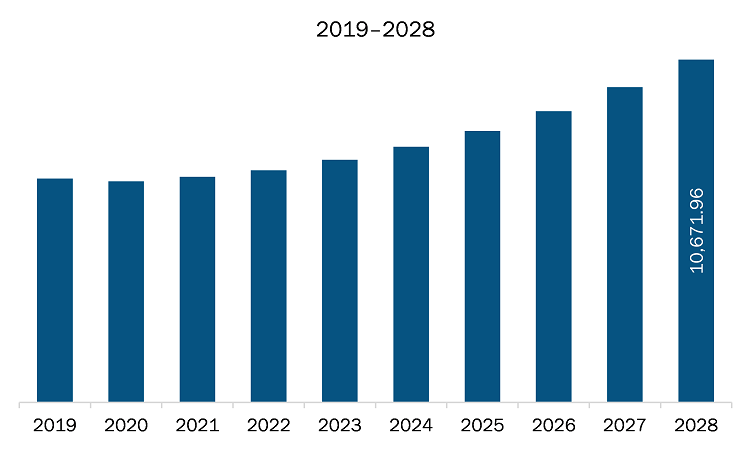The mechanical ventilation systems market in Asia Pacific is expected to grow from US$ 7022.97 million in 2021 to US$ 10671.96 million by 2028; it is estimated to grow at a CAGR of 6.2% from 2021 to 2028.
Growing innovations in energy recovery ventilation is anticipated to provide lucrative growth opportunities for the mechanical ventilation system market. Prominent players are increasingly investing in the design and development of controlled ventilation that transfers heat from the warm exhaust air to the cold supply air to minimize energy and cost of heating ventilated air. A few energy recovery systems also use existing ductwork to manage the expenses. Efficient ducts can effectively reduce pressure drops in the system and improve overall performance. The incorporation of embedded devices in energy recovery systems prevent it from freezing and reduce frost formation that can damage heat exchangers. This further decreases the maintenance costs. Increased focus on indoor climate have increased demand for turn-key heating, ventilation, and air conditioning (HVAC) solutions and integrated cooling methodologies. This is enabling the market vendors to invest in technologies that helps to obtain good thermal comfort and indoor air quality in warm summer seasons. The technological development in the HVAC industry is focused on cost down initiatives and improvements of existing technology. There is a growing demand for latent heat storage, with higher storage density and smaller temperature changes. The potential use of Phase Change Material (PCM) in HVAC solutions for thermal storage and temperature maintenance applications, and innovations in the Next Generation Ventilation (NeGeV) to optimize system performance and cater to the ventilation and cooling demands for commercial and industrial sectors are among the factors bolstering the growth of the market. Further, significant developments and innovations in mechanical ventilation systems are anticipated to match current price levels and greatly reduce operating costs while offering 50–90% reduced energy consumption and a reduced carbon footprint. All the aforementioned factors are expected to support market growth and offer lucrative growth opportunities to market players.
The region is characterized by the presence of several developing countries, positive economic outlook, and huge industrial sector, in addition to the largest share of global population. These factors make Asia Pacific a major region for the growth of the Mechanical ventilation system market. The shutdown of various plants and factories in many economies in the Asia Pacific has affected the supply chains and negatively impacting the manufacturing processes, delivery schedules, and product and service sales. The Asia Pacific is global manufacturing hub with countries such as China, Japan, and South Korea leading the global manufacturing sector. Disruptions in supply chains and manufacturing activities have led to the discontinuation of the production of new mechanical ventilation system, which is hindering the market growth. Meanwhile, with the initiation of vaccination drive coupled with reopening of economies the mechanical ventilation system market witness positive growth from the Q1 of 2021.
With the new features and technologies, vendors can attract new customers and expand their footprints in emerging markets. This factor is likely to drive the Asia Pacific mechanical ventilation systems market. The Asia Pacific mechanical ventilation systems market is expected to grow at a good CAGR during the forecast period.
- This FREE sample will include data analysis, ranging from market trends to estimates and forecasts.
Asia Pacific Mechanical Ventilation Systems Market Segmentation
Asia Pacific Mechanical Ventilation Systems Market – By Type
- Exhaust Ventilation
- Supply Ventilation
- Balanced Ventilation
- Energy Recovery Ventilation
Asia Pacific Mechanical Ventilation Systems Market – By Application
- Industrial
- Residential
- Commercial
Asia Pacific Mechanical Ventilation Systems Market – By Country
- Australia
- China
- India
- Japan
- South Korea
- Rest of APAC
Asia Pacific Mechanical Ventilation Systems Market – Companies Mentioned
- Vortice
- BLAUBERG
- Infineon Technologies AG
- AERMEC
- Mitsubishi Electric Corporation
- Volution Group plc.
Asia Pacific Mechanical Ventilation Systems Report Scope
| Report Attribute | Details |
|---|---|
| Market size in 2021 | US$ 7022.97 Million |
| Market Size by 2028 | US$ 10671.96 Million |
| CAGR (2021 - 2028) | 6.2% |
| Historical Data | 2019-2020 |
| Forecast period | 2022-2028 |
| Segments Covered |
By Type
|
| Regions and Countries Covered | Asia-Pacific
|
| Market leaders and key company profiles |
|
- Historical Analysis (2 Years), Base Year, Forecast (7 Years) with CAGR
- PEST and SWOT Analysis
- Market Size Value / Volume - Regional, Country
- Industry and Competitive Landscape
- Excel Dataset
Recent Reports
Testimonials
Reason to Buy
- Informed Decision-Making
- Understanding Market Dynamics
- Competitive Analysis
- Identifying Emerging Markets
- Customer Insights
- Market Forecasts
- Risk Mitigation
- Boosting Operational Efficiency
- Strategic Planning
- Investment Justification
- Tracking Industry Innovations
- Aligning with Regulatory Trends





















 Get Free Sample For
Get Free Sample For